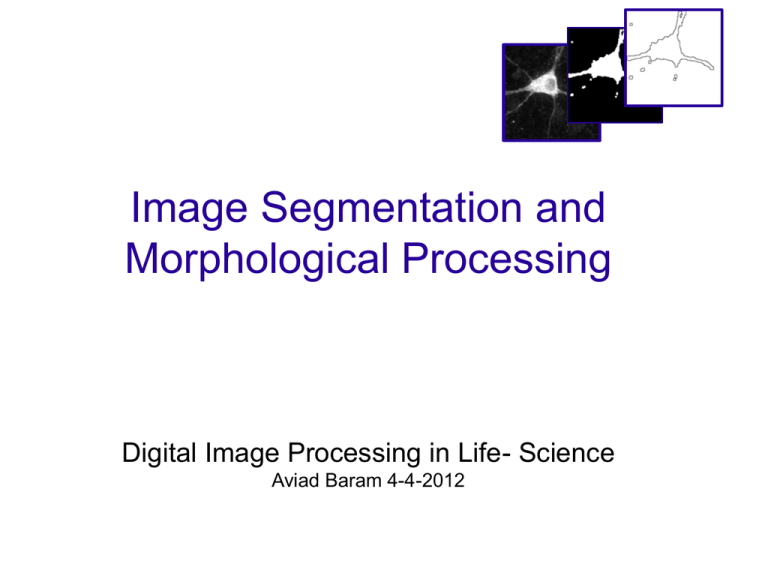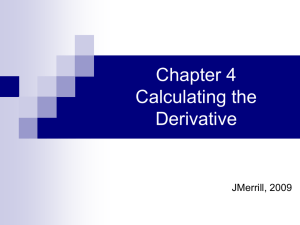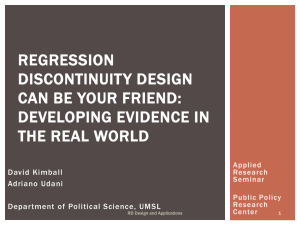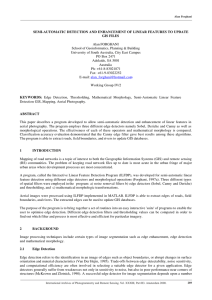R i - Weizmann Institute of Science
advertisement

Image Segmentation and
Morphological Processing
Digital Image Processing in Life- Science
Aviad Baram 4-4-2012
Processing vs Analysis
Image processing:
Enhance
Smooth
contrast
Image In
Image out
Image analysis:
“meaning”
Region
Edges
Image In
Attributes
out
Part I - Segmentation
Subdivide the image into constituent regions or
objects (sets)
n
∑ Ri =R
Q (Ri )≠ Q (R j )
i=1
Based on properties of intensity values
▪
Discontinuity – changes (e.g. edges)
▪
Similarity – partition into similar regions
Basic set operations
Exclusive
or
(R
⊕R
cg)
r(R
Complementary
Intersect
(R
∩R
)
r
g
rg
Union (Rr∪Rg) )
Synonyms in set operations
Selection
Binary
Mathematical
ROI
Mask
Set (Ri)
Make Inverse
Inverse
Complementary (Ric)
OR (Combine)
OR
Union (Ri∪Rj)
AND
AND
Intersect (Ri∩Rj)
XOR
Exclusive
disjunction (Ri⊕Rj)
XOR
Automatic approaches
Why?
Human comprehension is far superior
Unbiased
High throughput – ImageJ macros
■
■
Discontinuity – Edge based methods
■
Classical gradient detectors (Sobel, Prewitt...)
■
Canny edge detector
Similarity - threshold
Edge detection
Find the boundary of a region by identifying
points, lines and edges
Tools:
▪
▪
Second derivatives (Laplacian) operators
▪
Very sensitive to noise
▪
Double line detection (show example)
First derivative
▪
Smoother
▪
Less sensitive
Derivatives noise
First derivative
Second derivative
Derivatives noise
First derivative
Second derivative
Derivatives noise
First derivative
Second derivative
Laplacian double edge
Prewitt and Sobel
Derivative
Sobel
-2
-1
0
-1
0
1
0
1
2
Laplacian of Gaussian - LoG
Laplacian
LoG
Canny edge detector
Nonmaxima suppression along gradient
Double threshold → use TH edge pixels
as seeds to connect TL edges
norm
angle
Edge detection Summary
1st derivative
2nd derivative
Source
Sobel
LoG
Canny
Similarity - Threshold
Partition Image into regions
▪
Global threshold
▪
Adaptive threshold
▪
Smaller image blocks
▪
Threshold for each blocks
▪
Interpolate results for each pixels
Global threshold - noise
T1
{
a
g (x,y )= b
c
iff (x,y )>T 2
ifT1<f (x,y )≤ T 2
iff (x,y )≤ T 1
}
c
T2
b
a
Global threshold - background
Automatic global threshold
Example 1 - mean:
Initial estimate
for T
Segment into
G1 and G2
Compute mean
for G1 and G2
Repeat until no significant change
G1
G2
⟨G1⟩
⟨G2⟩
Compute new
threshold
T=
1
(⟨G 1 ⟩+ ⟨G 2 ⟩ )
2
Automatic global threshold
Example 2 – Otsu: minimize error in pixel
assignment to groups
mean1
Global mean: mG
Global variance: σ2G
mean2
Between-class variance: σ2B
Calculate for all
thresholds and choose
the max σ2B
2
“goodness” of TH:
η=
σB
2
σG
smoothing images
improves auto segmentation
Local thresholding
Calculate T from “subimage” histogram (e.g.
edges...) ⇒ apply to full image
Variable thresholding
For each pixel, f(x,y), compute a threshold, Txy,
based on mxy and σxy of neighborhood Sxy
m - mean
Mean
T xy =aσ xy +bm xy
T xy =aσ xy +bmG
{
1
g (x,y )=
0
iff (x,y )>T xy
iff (x,y )≤ T xy
}
σ - variance
Part II - Morphology
Processing of region shapes
Structuring Elements
Erosion
A⊖B
Erosion
Remove connecting lines
Shrink regions
Dilation
A⊕
B
Dilation
Bridge gaps
Grow regions
Dilate⇔ErodeC
Open
A◦B
nX Erode → n X dilate
Smooth contour
Break narrow bridges
Eliminate protrusions
Close
A•B
nX dilate → n X erode
Smooth contour
Fuse narrow breaks
Eliminate small holes
Fills gaps
Open⇔CloseC
Boundary extraction
Subtract the eroded image from original
Skeletons
Minimal set required for reconstruction
ImageJ built in function – erode to single pixel
Fill holes
Hole – background region surrounded by a foreground connected border
Hit or Miss
Shape detection
C
A⊛B=(A⊖B1)∩(A ⊖B2)
Probe for object
Probe for background
Watershed
Gray level
Segmentation
ImageJ built in
ImageJ Set Measurement...
Gray level morphology
Erode
Open
Dilate
Close
Examples
Yael Mutsafi
Ayelet Tetelboim







